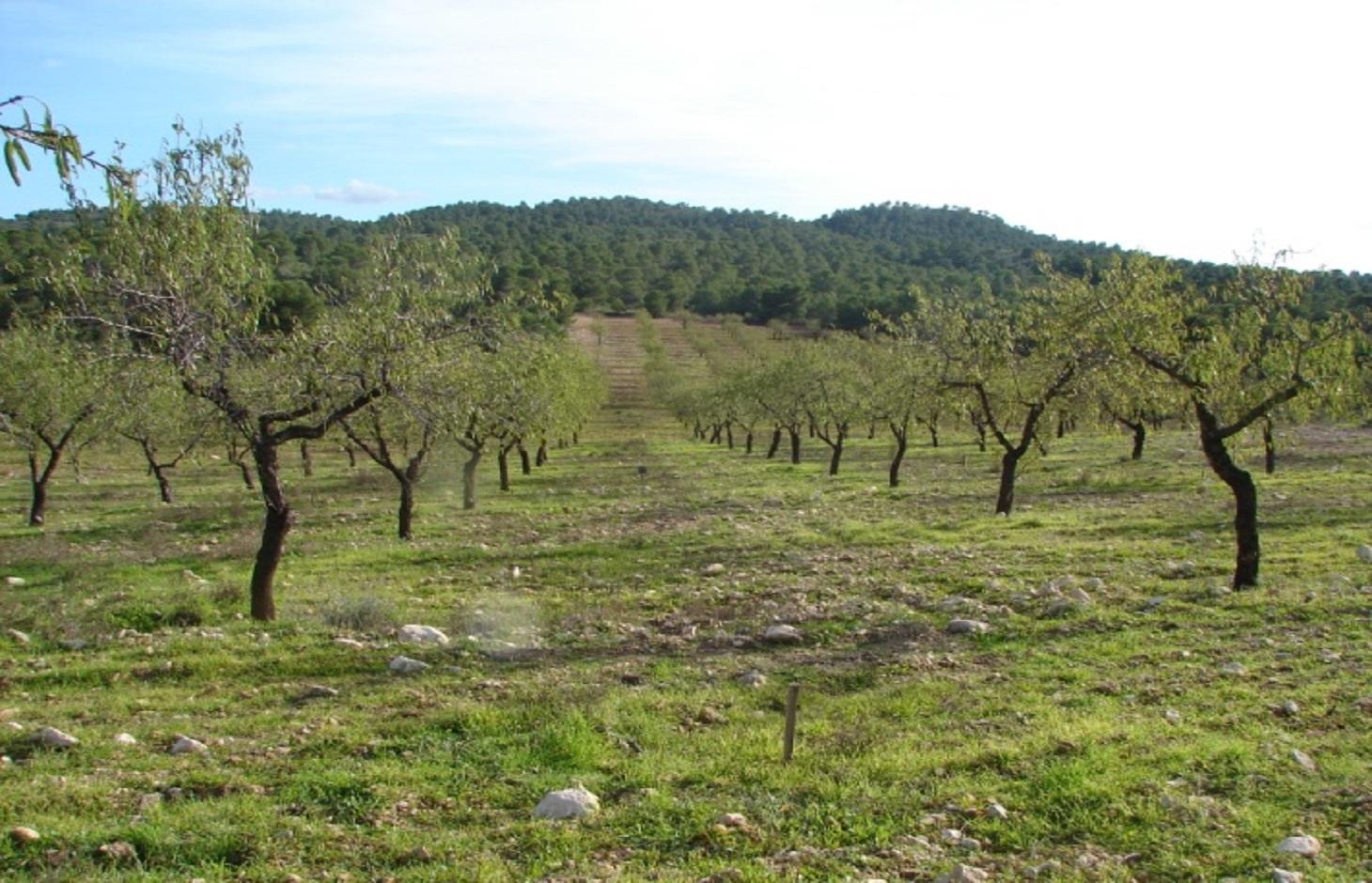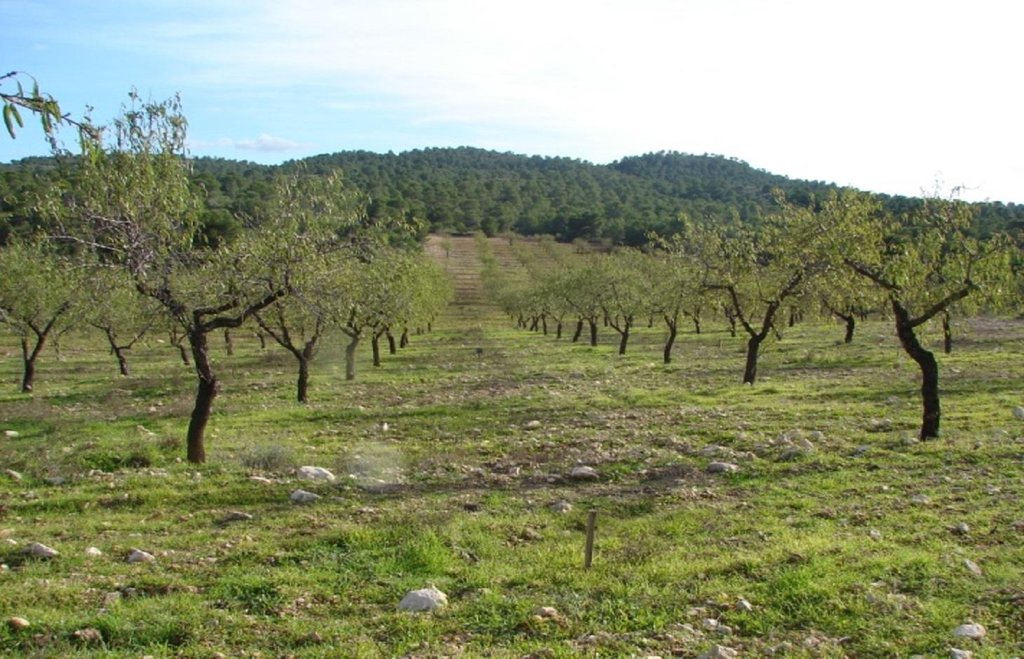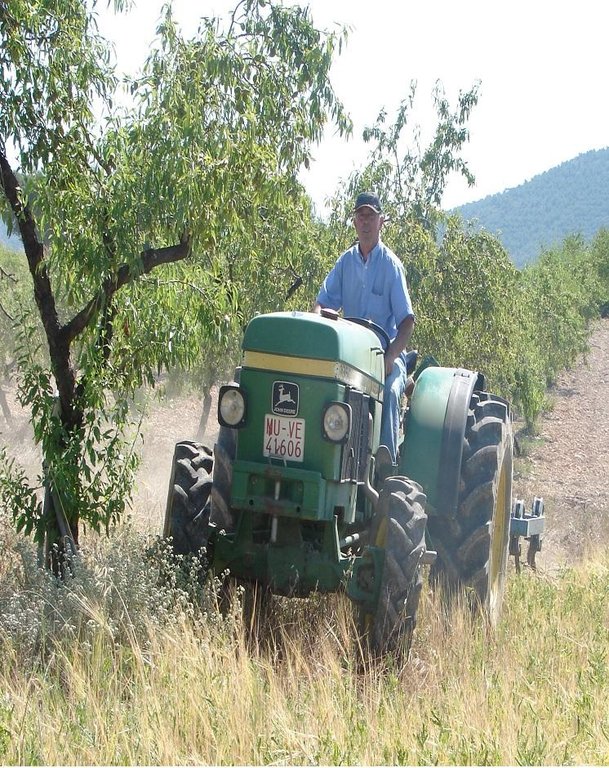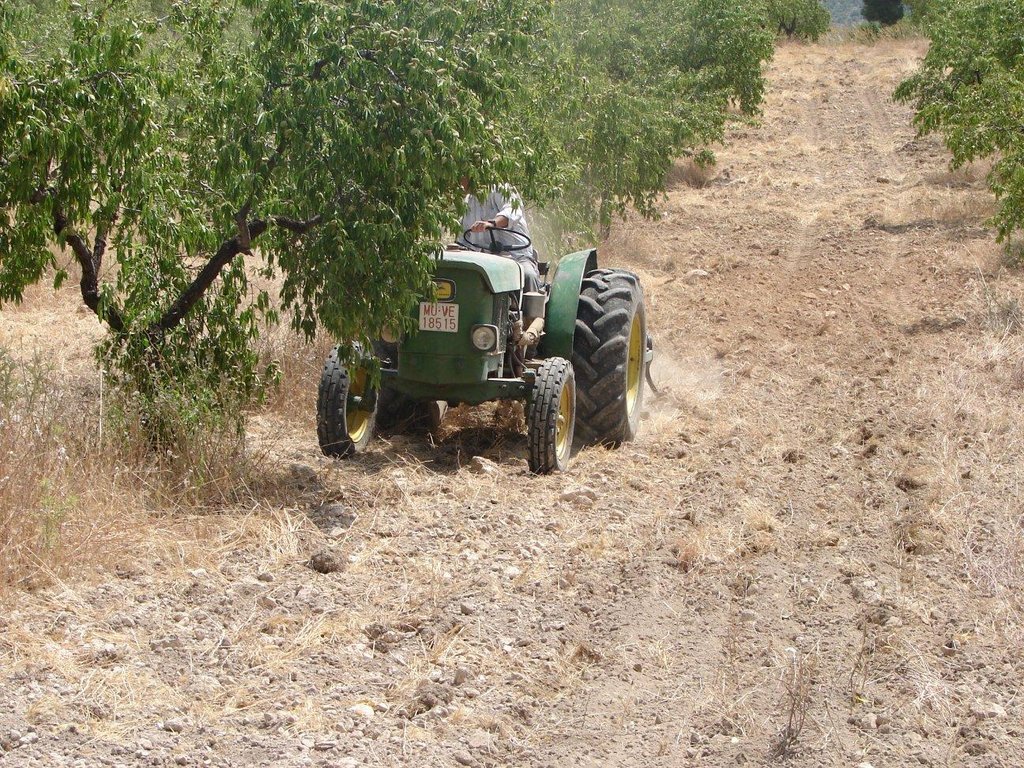Reduced tillage of almonds and olives [西班牙]
- 创建:
- 更新:
- 编制者: Joris De Vente
- 编辑者: –
- 审查者: Deborah Niggli, Alexandra Gavilano
Labranza reducida de almendros y olivos
technologies_1711 - 西班牙
查看章节
全部展开 全部收起1. 一般信息
1.2 参与该技术评估和文件编制的资源人员和机构的联系方式
有助于对技术进行记录/评估的项目名称(如相关)
DESIRE (EU-DES!RE)有助于对技术进行记录/评估的机构名称(如相关)
EEZA-CSIC (EEZA-CSIC) - 西班牙1.3 关于使用通过WOCAT记录的数据的条件
编制者和关键资源人员接受有关使用通过WOCAT记录数据的条件。:
是
2. SLM技术的说明
2.1 技术简介
技术定义:
Reduced tillage of almonds and olives to improve physical and chemical soil properties and reduce runoff and soil erosion.
2.2 技术的详细说明
说明:
Reduced tillage of almond and olive orchards is used to decrease fuel use and emission of greenhouse gases and maintain a higher surface cover by weeds during winter time in order to protect the soil from erosion.
Purpose of the Technology: Under reduced tillage, the fields are ploughed twice a year: once in autumn (November) and once in late sping (June), whereas under conventional tillage fields are ploughed 3-5 times per year. The aim of reduced tillage is to maintain better surface cover during winter months to reduce runoff and soil erosion. After several years this will result in a higher soil organic matter content, a better soil structure, and a higher soil water infiltration capacity. The soil cover by weeds reduces the sensitivity of the soil to surface crusting and reduces surface runoff and soil erosion by up to 60%. Workload and energy use with reduced tillage is up to 50% lower than under conventional agriculture. The increased farm income prevents land abandonment of marginal lands with low productivities under conventional farming. Reduced tillage of almonds does not require special establishment activities or investments in specialized equipment.
Natural / human environment: Reduced tillage can easily be combined with green manure and ecological agriculture as is described in QT SPA05: ecological production of almonds and olives using green manure. Soils have mostly a shallow to medium depth (between 20-60 cm), and slopes are gentle to moderate between 5 and 15%. The climate is semi-arid with a mean annual rainfall around 300 mm. Droughts, centred in summer, commonly last for more than 4-5 months. Annual potential evapotranspiration rates greater than 1000 mm are common. The production system is highly mechanized and market oriented but depends strongly on agricultural subsidies. All cropland is privately owned.
2.3 技术照片
2.5 已应用该技术的、本评估所涵盖的国家/地区/地点
国家:
西班牙
区域/州/省:
Murcia
有关地点的进一步说明:
Guadalentín catchment
具体说明该技术的分布:
- 均匀地分布在一个区域
如果不知道精确的区域,请注明大致覆盖的区域:
- 10-100 平方千米
2.6 实施日期
如果不知道确切的年份,请说明大概的日期:
- 不到10年前(最近)
2.7 技术介绍
详细说明该技术是如何引入的:
- 通过项目/外部干预
3. SLM技术的分类
3.2 应用该技术的当前土地利用类型
同一土地单元内混合使用的土地::
是
具体说明混合土地使用(作物/放牧/树木):
- 农林业

农田
- 乔木与灌木的种植
乔木和灌木种植 - 指定作物:
- 橄榄树
- 树坚果(巴西坚果、开心果、核桃、杏仁等)
具体说明:
Longest growing period in days: 220Longest growing period from month to month: Nov-Jun

牧场

森林/林地
注释:
Major land use problems (compiler’s opinion): Lack of water for irrigation of crops limiting the crop types that can be planted as well as the crop yield of dryland farming. A lack of water availability seriously limits the production potential of the soil and results in a low vegetation/crop cover. The relatively high soil erosion rates cause various off-site related problems (i.e. flooding, reservoir siltation) and on-site problems (i.e. gully formation and reduced soil depth).
Livestock is grazing on crop residues
3.5 该技术所属的SLM组
- 改良的地面/植被覆盖
- 最小的土壤扰动
- Reduced tillage
3.6 包含该技术的可持续土地管理措施

农艺措施
- A7:其它
注释:
Main measures: agronomic measures
Specification of other agronomic measures: reduced tillage
3.7 该技术强调的主要土地退化类型

土壤水蚀
- Wo:场外劣化效应

化学性土壤退化
- Cn:肥力下降和有机质含量下降(非侵蚀所致)
- Cp:土壤污染

生物性退化
- Bp:害虫/疾病增加,捕食者减少
注释:
Main type of degradation addressed: Wo: offsite degradation effects, Cn: fertility decline and reduced organic matter content, Cp: soil pollution, Bp: increase of pests / diseases, loss of predators
Main causes of degradation: soil management, education, access to knowledge and support services
Secondary causes of degradation: crop management (annual, perennial, tree/shrub)
3.8 防止、减少或恢复土地退化
具体数量名该技术与土地退化有关的目标:
- 防止土地退化
- 减少土地退化
注释:
Main goals: prevention of land degradation, mitigation / reduction of land degradation
4. 技术规范、实施活动、投入和成本
4.1 该技术的技术图纸
技术规范(与技术图纸相关):
Autumn ploughing of an almond orchard with reduced tillage
Technical knowledge required for field staff / advisors: high
Technical knowledge required for land users: moderate
Main technical functions: control of dispersed runoff: retain / trap, control of dispersed runoff: impede / retard, control of concentrated runoff: retain / trap, improvement of ground cover
Secondary technical functions: increase in organic matter, increase of infiltration, increase / maintain water stored in soil
作者:
Joris de Vente
4.5 维护/经常性活动
| 活动 | 时间/频率 | |
|---|---|---|
| 1. | 1. Ploughing twice a year instead of 3-5 times(resulting in a reduction of the costs compared to the conventional tillage practice) |
4.6 维护/经常性活动所需要的费用和投入(每年)
注释:
Machinery/ tools: Costs were assessed comparing conventional land management with reduced tillage, which needs less inputs thus meaning a saving compared to conventional practice. Fuel price is the most determining factor affecting the costs. The local wage rate is 79 US$/
The local wage rate is 79 US$/day. Prices are for spring 2008.
4.7 影响成本的最重要因素
描述影响成本的最决定性因素:
Costs were assessed comparing conventional land management with reduced tillage, which needs less inputs thus meaning a saving compared to conventional practice (97 USD per hectare per year). Fuel price is the most determining factor affecting the costs.
5. 自然和人文环境
5.1 气候
年降雨量
- < 250毫米
- 251-500毫米
- 501-750毫米
- 751-1,000毫米
- 1,001-1,500毫米
- 1,501-2,000毫米
- 2,001-3,000毫米
- 3,001-4,000毫米
- > 4,000毫米
农业气候带
- 半干旱
Thermal climate class: subtropics
5.2 地形
平均坡度:
- 水平(0-2%)
- 缓降(3-5%)
- 平缓(6-10%)
- 滚坡(11-15%)
- 崎岖(16-30%)
- 陡峭(31-60%)
- 非常陡峭(>60%)
地形:
- 高原/平原
- 山脊
- 山坡
- 山地斜坡
- 麓坡
- 谷底
垂直分布带:
- 0-100 m a.s.l.
- 101-500 m a.s.l.
- 501-1,000 m a.s.l.
- 1,001-1,500 m a.s.l.
- 1,501-2,000 m a.s.l.
- 2,001-2,500 m a.s.l.
- 2,501-3,000 m a.s.l.
- 3,001-4,000 m a.s.l.
- > 4,000 m a.s.l.
关于地形的注释和进一步规范:
Landforms: plateau / plains, hill slopes, footslopes, valley floors
5.3 土壤
平均土层深度:
- 非常浅(0-20厘米)
- 浅(21-50厘米)
- 中等深度(51-80厘米)
- 深(81-120厘米)
- 非常深(> 120厘米)
土壤质地(表土):
- 中粒(壤土、粉土)
表土有机质:
- 低(<1%)
如有可能,附上完整的土壤描述或具体说明可用的信息,例如土壤类型、土壤酸碱度、阳离子交换能力、氮、盐度等。:
Soil fertility is low
Soil drainage/infiltration is poor
Soil water storage capacity is medium
5.4 水资源可用性和质量
地下水位表:
5-50米
地表水的可用性:
匮乏/没有
水质(未处理):
仅供农业使用(灌溉)
5.5 生物多样性
物种多样性:
- 低
5.6 应用该技术的土地使用者的特征
生产系统的市场定位:
- 商业/市场
非农收入:
- > 收入的50%
相对财富水平:
- 平均水平
个人或集体:
- 个人/家庭
机械化水平:
- 机械化/电动
性别:
- 男人
说明土地使用者的其他有关特征:
Land users applying the Technology are mainly common / average land users
Population density: 10-50 persons/km2
Annual population growth: < 0.5%
80% of the land users are average wealthy and own 75% of the land.
Off-farm income specification: There is no difference in the ones who apply the technology and those who don’t. Most farmers do have an off-farm income for example from hunting, work in a factory, or office.
5.7 应用该技术的土地使用者使用的平均土地面积
- < 0.5 公顷
- 0.5-1 公顷
- 1-2 公顷
- 2-5公顷
- 5-15公顷
- 15-50公顷
- 50-100公顷
- 100-500公顷
- 500-1,000公顷
- 1,000-10,000公顷
- > 10,000公顷
这被认为是小规模、中规模还是大规模的(参照当地实际情况)?:
- 小规模的
5.8 土地所有权、土地使用权和水使用权
土地所有权:
- 个人,有命名
土地使用权:
- 个人
用水权:
- 个人
5.9 进入服务和基础设施的通道
教育:
- 贫瘠
- 适度的
- 好
技术援助:
- 贫瘠
- 适度的
- 好
就业(例如非农):
- 贫瘠
- 适度的
- 好
市场:
- 贫瘠
- 适度的
- 好
能源:
- 贫瘠
- 适度的
- 好
道路和交通:
- 贫瘠
- 适度的
- 好
饮用水和卫生设施:
- 贫瘠
- 适度的
- 好
金融服务:
- 贫瘠
- 适度的
- 好
6. 影响和结论性说明
6.1 该技术的现场影响
社会经济效应
收入和成本
农业收入
工作量
社会文化影响
娱乐机会
SLM/土地退化知识
Improved livelihoods and human well-being
注释/具体说明:
Farm income of most farmers has increased due to lower production costs
生态影响
水循环/径流
地表径流
土壤
土壤水分
土壤覆盖层
土壤流失
土壤结壳/密封
土壤有机物/地下C
生物多样性:植被、动物
植物多样性
减少气候和灾害风险
碳和温室气体的排放
6.2 该技术的场外影响已经显现
下游淤积
对邻近农田的破坏
6.3 技术对渐变气候以及与气候相关的极端情况/灾害的暴露和敏感性(土地使用者认为的极端情况/灾害)
渐变气候
渐变气候
| 季节 | 增加或减少 | 该技术是如何应对的? | |
|---|---|---|---|
| 年温度 | 增加 | 好 |
气候有关的极端情况(灾害)
气象灾害
| 该技术是如何应对的? | |
|---|---|
| 局地暴雨 | 好 |
| 局地风暴 | 好 |
气候灾害
| 该技术是如何应对的? | |
|---|---|
| 干旱 | 不好 |
水文灾害
| 该技术是如何应对的? | |
|---|---|
| 比较和缓的(河道)洪水 | 好 |
其他气候相关的后果
其他气候相关的后果
| 该技术是如何应对的? | |
|---|---|
| 缩短生长期 | 好 |
注释:
The crop type is sensitive to changes in water availability under the semi-arid conditions.
6.4 成本效益分析
技术收益与技术建立成本相比如何(从土地使用者的角度看)?
短期回报:
稍微积极
长期回报:
稍微积极
技术收益与技术维护成本/经常性成本相比如何(从土地使用者的角度看)?
短期回报:
稍微积极
长期回报:
稍微积极
6.5 技术采用
在所有采用这项技术的人当中,有多少人是自发的,即未获得任何物质奖励/付款?:
- 91-100%
注释:
100% of land user families have adopted the Technology without any external material support
There is a moderate trend towards spontaneous adoption of the Technology
6.7 该技术的优点/长处/机会
| 编制者或其他关键资源人员认为的长处/优势/机会 |
|---|
|
Reduced tillage has a very positive effect on the reduction of erosion and runoff, on soil quality and biodiversity How can they be sustained / enhanced? If maintained it will lead potentially to higher yields after several years |
|
Production costs are reduced How can they be sustained / enhanced? Yield and farm income may be increased by combining this technology with green manure under ecological agriculture (QT SPA05) |
6.8 技术的弱点/缺点/风险及其克服方法
| 编制者或其他关键资源人员认为的弱点/缺点/风险 | 如何克服它们? |
|---|---|
| On the short term no increase in yield is obtained | Combine the technique with green manure or ecological agriculture as described in QT SPA05 |
7. 参考和链接
7.1 信息的方法/来源
7.2 参考可用出版物
标题、作者、年份、ISBN:
Holland, J.M., 2004. The environmental consequences of adopting conservation tillage in Europe: reviewing the evidence. Agriculture, Ecosystems & Environment, 103(1): 1-25.
链接和模块
全部展开 全部收起链接
无链接
模块
无模块





